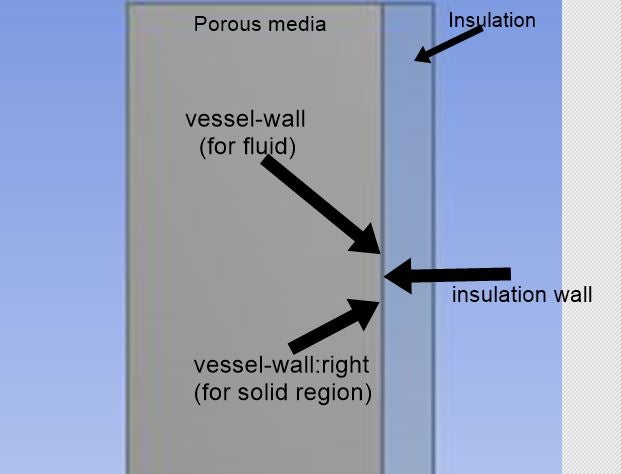TAGGED: interface-boundary, porous-media, wall-shadow
-
-
August 25, 2021 at 5:55 pm
rajendrapor
SubscriberI am trying to simulate CHT to a porous media where a local thermal non-equilibrium (LTNE) model is used. When the LTNE model is invoked the wall is separated into two, i.e. one for the solid region and one for fluid. Additionally, I have a wall for the adjacent insulation. The figure is attached here. I have assigned the boundary condition (BC) interface to all three walls. When the mesh interface is applied to all three walls, I come up with 2 shadows and 5 walls. This is undesirable in my case. I wish to obtain a wall and 2 shadows.
September 1, 2021 at 1:27 pmKarthik Remella
AdministratorHello Why do you think this is incorrect?
If I'm thinking about this correct, you should have 2 coupled walls:
fluid_vessel - solid_vessel
fluid_vessel - insulation
Then, there should be additional solid walls. Can you check the adjacent zone for each of the walls and confirm if they make physical sense?
Karthik
September 2, 2021 at 5:59 amrajendrapor
SubscriberThanks for the reply!
As shown in the image, I am getting walls 79, 80, and 81. The adjacent zones are-(1) Fluid-phase; (2) Solid-phase of porous medium, and (3) insulation respectively. So this seems physically correct.
However, I need to consider heat transferred from the wall to fluid and solid of porous medium distinctly, I am not sure how it would be done or handled by fluent!!
The heat conduction equation will be solved for the insulation zone, thus giving the wall temperature on the left side of insulation (say, T_ins_left). Now, this T_ins_left would be responsible for heat transfer at the interface of porous medium and insulation. Where the heat transfer source terms are added distinctly to the solid and fluid phases of the porous medium.
So, I need to assign different BCs to the insulation-solid_vessel and insulation-fluid_vessel.
Any help would be greatly appreciated.
September 2, 2021 at 1:54 pmKarthik Remella
AdministratorHello Please start from scratch. Split the walls which were coupled, and then manually create the coupling on walls that need to be connected. This can be a little tricky and confusing. The best way to do this would be to keep monitoring the adjacent cell zone. Unfortunately, I will not able to give you the detailed steps without knowing the exact details.
Karthik
September 2, 2021 at 4:00 pmrajendrapor
SubscriberKindly, let me know what details should I furnish for a better understanding. Till then, I am monitoring the adjacent zones and the walls so formed.
To simply say, the LTNE model of Fluent does not take into consideration the heat transfer at the wall in a porous media. I wish to incorporate this mechanism in the model as the source terms. Where the wall is surrounded by insulation; thus, the conjugate heat transfer comes into the picture. Since LTNE model is invoked, two walls are there due to porous media and one due to insulation.
However, it is not clear to me how fluent handles the interfaces for CHT under LTNE model. And surprisingly, the Fluent documentation does not have enough information about LTNE models.
Viewing 4 reply threads- The topic ‘Boundary condition at wall for conjugate heat transfer (CHT) in porous media using LTNE model?’ is closed to new replies.
Innovation SpaceTrending discussionsTop Contributors-
4618
-
1530
-
1386
-
1210
-
1021
Top Rated Tags© 2025 Copyright ANSYS, Inc. All rights reserved.
Ansys does not support the usage of unauthorized Ansys software. Please visit www.ansys.com to obtain an official distribution.
-
The Ansys Learning Forum is a public forum. You are prohibited from providing (i) information that is confidential to You, your employer, or any third party, (ii) Personal Data or individually identifiable health information, (iii) any information that is U.S. Government Classified, Controlled Unclassified Information, International Traffic in Arms Regulators (ITAR) or Export Administration Regulators (EAR) controlled or otherwise have been determined by the United States Government or by a foreign government to require protection against unauthorized disclosure for reasons of national security, or (iv) topics or information restricted by the People's Republic of China data protection and privacy laws.












